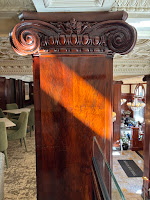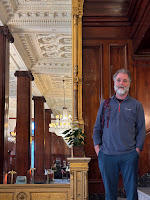
After about six months of Mark dropping hints that I could join him for yoga at the local YMCA (yoga isn’t my cup of tea, though), I’ve re-started my fitness regime. This involves wearing a fitness tracker that talks with my mobile, and spending time on a health app keeping a food diary of weighed out serving portions. And waking up early and going to the Y to either swim, or run on an elliptical, or clink weights. Or sit in the hot tub.
I want to say the increase in activity has been good for my mood, so yay. If I can continue to exercise consistently through September, I’m hoping habit will carry me through the Very Very Long Grey Months around the Winter Solstice. I also want to say that my body is thinking about beginning to look a little more toned, so also yay.
I’m surprised by my sleep patterns: based on motion and heart rate, I wake up a lot more during the night than I realized and I actually sleep a lot less than the seven or eight hours I thought I was getting. It would be interesting to correlate when the tracker thinks I’m in REM sleep with an actual EEG.
The other weekend I went dancing. Mark opted out. The producers of the dance were the same folks who produced the Pride After-party.
I arrived at a local Queer/Pagan bar a little after 9 PM, when the event started. The music was pumping out, folks were around the bar and tables, and the dance floor was empty.
The theme of the dance was “Hanky Panky”; folks were supposed to wear a colored bandana in one of their back pockets to signify what kind of sexual activities they’re into. Since there is no hanky for “My husband stayed home, and I’m just here to dance,” my back pockets were bare and I wore a black T-shirt with a rampant rainbow unicorn on it. In retrospect, I should have worn a mirror-ball keychain… perhaps with a T-shirt reading “My ball-and-chain is a disco ball.”
I ordered a cola product and inspected the decor. This is somewhere between a theatre production of the Addams Family, an occult bookstore, a Hot Topic shop, and a leather bar—with a covered and fenced-in porch on the side.
I finished my drink, figured someone had to be the first person dancing, and headed to the stage end of the bar. The DJ, smiling, left his control panel, bounded past a Saint Andrew’s Cross and a bondage bench, underneath the big screen showing campy and risqué videos, through the strobing and whirling stage lights, past a dancer’s cage, and met me on the dance floor. “You’re early!” he said, and then introduced himself. Technically the dance’s start time was 9—but things wouldn’t get started until about 10 or 10:30.
This was fine by me, because I wouldn’t have to worry about stepping on somebody or thwacking them with an upthrust arm accidentally while I shook the rust off of my dance moves—which I’ll be the first to admit are a cross between cha-cha, the fox-trot, an aerobics routine, and a ritual summoning.
The music was a fun repeat of the mix during the previous week’s After Party, and, luckily, not quite as loud, as I had forgotten my ear plugs at home. The video on the big screen was a slightly more X-rated version of the previous week’s PG-13 video.
The dance floor filled up, and then go-go boys in day-glow fetish-wear jumped onto the stage. I’m not sure if they were dancers who strip, or strippers who dance, but at least they seemed to be having fun. Especially in the cage. My sense is that they had friends in the audience.
I danced and danced, and briefly re-connected with a queer pagan acquaintance I hadn’t seen in about two years; he went back to dancing with his partner, who was in a wheelchair.
Just a quickly as it had filled up, around 11:30, the dance floor cleared. I remember this used to happen thirty years ago at Perry’s On Pearl: you’d be dancing to the music, look up, and realize that about half of the dancers had left, presumably with each other. The energy of the room would shift from summer lovin’ to autumnal lean and prowling.
When I stepped out onto the smoking patio looking to chat up my acquaintance and his partner, I realized A) it was cooler out here; B) oh yeah, this was where people actually smoked, and; C) a bear in a leather jockstrap and harness wasn’t just waving hi, he was offering me a joint.
Actually, I’m pretty sure he was offering my hair a joint.
I smiled and said, “Thanks; I don’t smoke.”
“What?” he said in mock-horror. “A man dancing with long grey hippie hair doesn’t smoke weed?” (See, I was right; my hair had scored.)
“It’s true,” I said. “Thanks anyway.” —Not realizing until the next day when Mark told me that the leather bear was flirting with me that I missed the sub-text and was completely off script.
Note To Self: Next time, compliment a leather bear on his gear and ask him where he shops.
I went back inside. While the fantasy cater-waiter dance scene from the movie “Jeffry” played on the screen behind him, a lone go-go boy whirled some LED poi in front of a mostly empty dance floor. Which was too bad, because if I had to choose, the go-go boy with the whirling lights was the most interesting one on stage, and he deserved more of an audience.
The night had reached an inflection point. A long time ago, someone taught me the difference between staying at a party because you’re having fun and staying at a party because you’re waiting for something to happen. If one is waiting for something to happen, one either needs to make something happen or leave. Even with the disco nap I’d taken that afternoon, I was feeling a little tired after about two and a half hours of almost solid dancing. So it was time to leave.
The next day my fitness tracker reported that I’d taken 6,183 steps and that I’d burned through 586 calories during my 95 minute “Aerobic Workout.” I can tell from the graph of my heart rate when I was enjoying dancing the most, but, alas, I can’t tell from the valleys and peaks where the poi-whirling go-go boy or the leather bear are.
I can, however, find Mark.





























